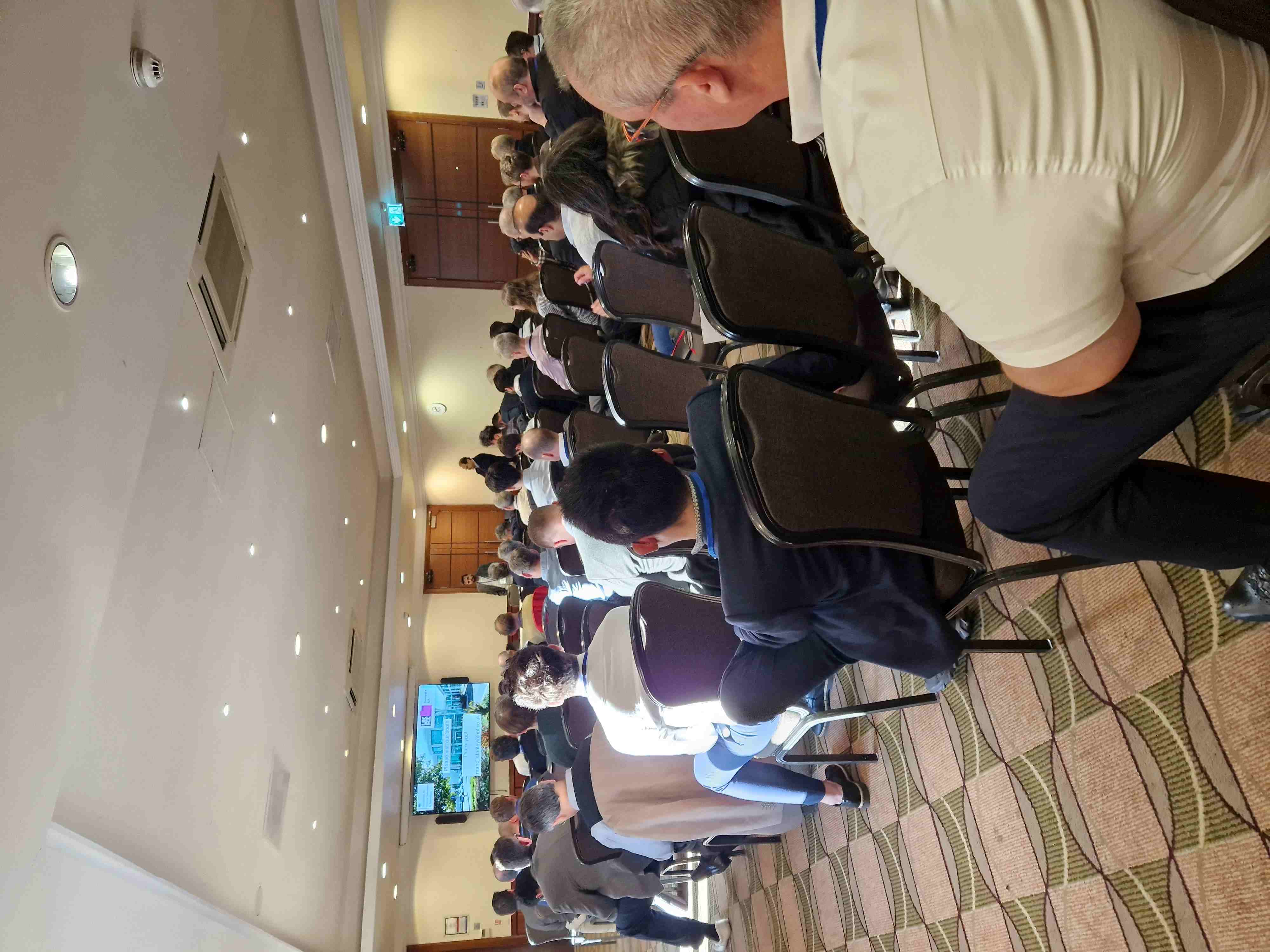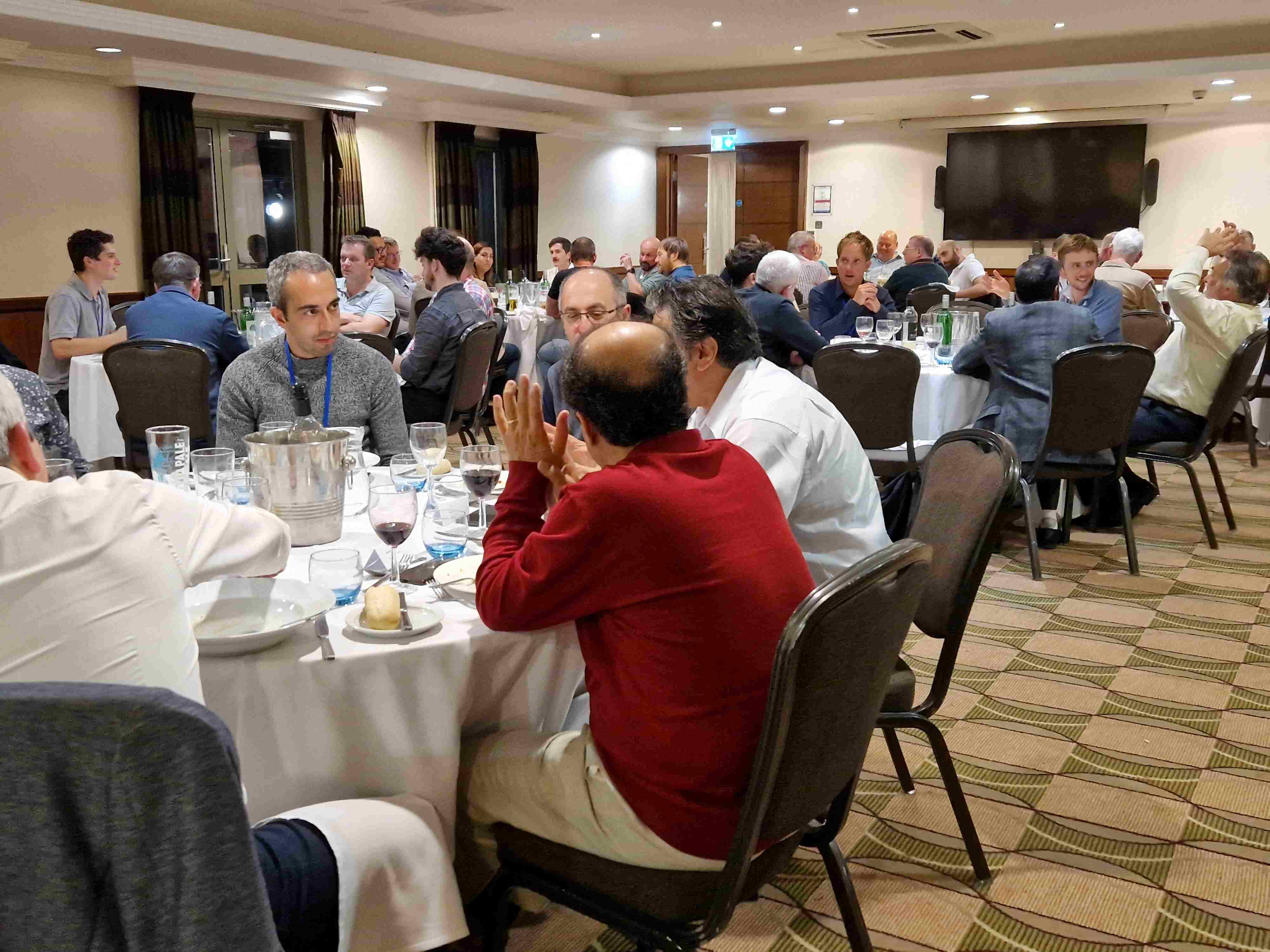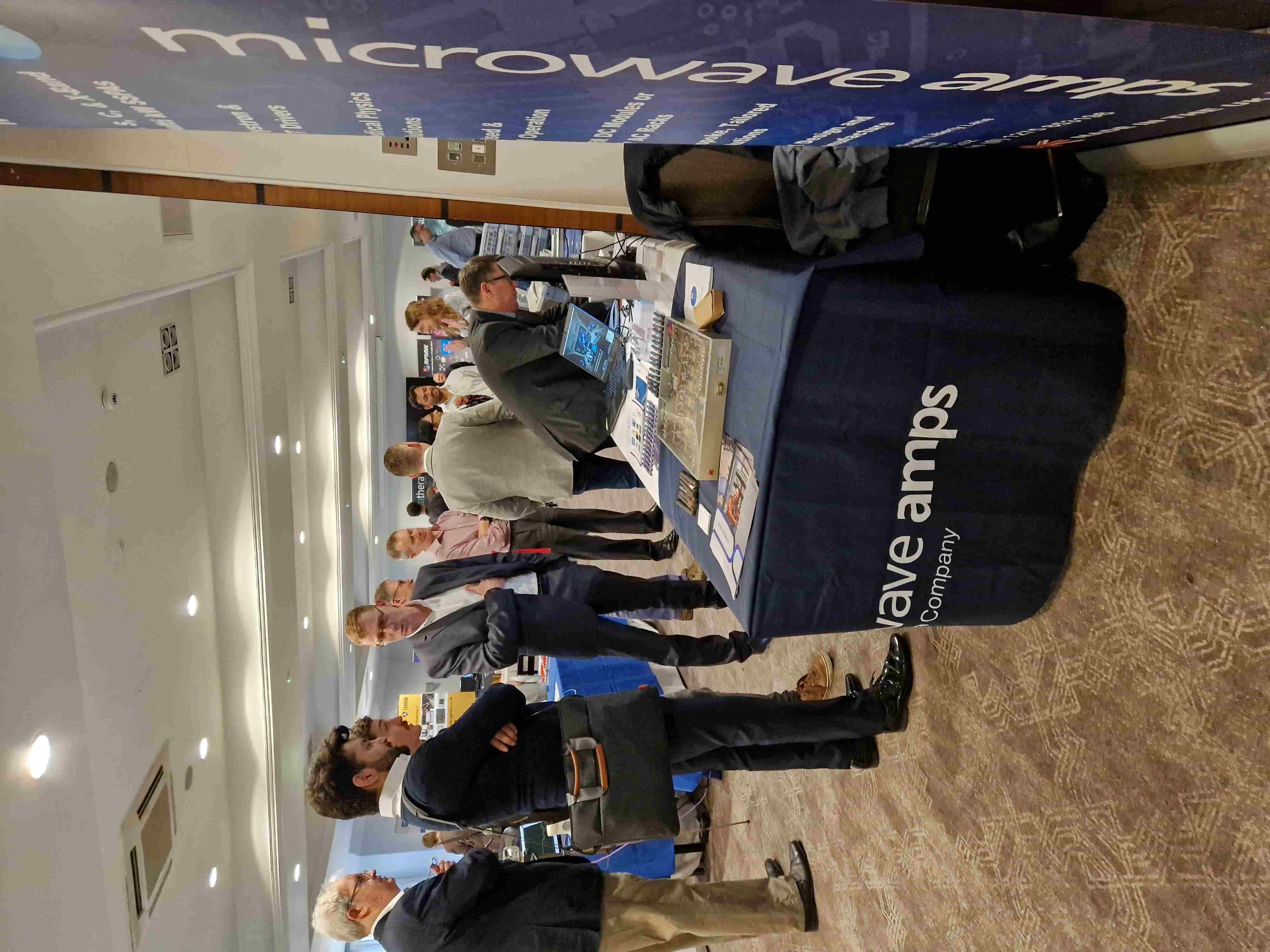Young Engineer Sponsorship: The ARMMS RF & Microwave Society provides sponsorship for young engineers (28 or below) who have had papers accepted for presentation at each meeting. Sponsorship is £200 cash plus free attendance (including conference dinner and overnight accommodation). Potential candidates should identify themselves as eligible at time of submission and state their date of birth. This offer is limited to a maximum of 2 places per meeting. A sponsored place at the November 2023 meeting were awarded to Arslan Altaf of Manchester Metropolitan University.
Best Paper Award: The Steve Evans-Pughe prize is awarded to the best presenter at each meeting. The prize is sponsored by Cadence. The best paper prize at the November 2023 conference was awarded to Karolin Werthmuller of Rhode & Schwarz with Harley Berman of Marki Microwave taking the second place.
If you are interested in submitting a paper for presentation at this conference, please contact the technical coordinator (details below). Papers currently listed below are those already accepted. The deadline for submissions is 7th of October 2023. For exhibition enquiries please email exhibition@armms.org, for all other enquiries please email enquiries@armms.org
 |  |  |
The Cambridge Belfry
Back Lane
Cambourne
Cambridgeshire
CB23 6BW
| Web | https://www.thecambridgebelfry.co.uk |
Kara (Mehmet Karaaslan)
A Cost-Effective and Compact, Discrete Phase Shifter for Beam Steering Applications | |
| Arslan Altaf | |
| Manchester Metropolitan University | |
This work presents a phase shifter design characterized by a modular, low-cost, and space-efficient architecture with applications to beam steering phased array antennas. The phase shifter occupies a compact core area of 1.6 cm², implemented on an FR4 substrate and encompasses 6 distinct operating phase states (0, 60, 120, 180, 240, and 300 degrees). Utilizing a high pass/low pass lumped element approach and two RF SP6T switches, the design leverages a reference state established through a transmission line to meet the target specifications. A strategic configuration of LC components is employed, consisting of lowpass PI and highpass TEE networks, implemented using SMD components. This approach minimises prototyping cost and time without compromising performance or size. To validate the topology, three boards were fabricated on an 8mil FR4 substrate. All prototypes show >10.5dB RL, <2.8dB IL and < ±28 deg of phase error within 3.8-4.2GHz. The proposed phase shifter is suitable for rapid and low-cost prototyping compared to a MMIC implementation. | |
| A Cost-Effective and Compact, Discrete Phase Shifter for Beam Steering Applications | |
A Novel Approach for Removing Instrument-Inherent Wideband Noise of Vector Signal Analyzers: Basic Principles and Impact | |
| Karolin Werthmueller, Ezer Bennour, Michael Simon, Florian Ramian | |
| Rohde & Schwarz | |
The recent developments in communication standards are clearly showing a trend towards higher signal bandwidths and higher modulation orders. As a direct consequence, the EVM performance requirements are becoming much more stringent for the devices under test as well as the test equipment. Therefore, the demand for enhancements that can improve the EVM performance of vector signal analyzers is considerably increasing. In this work, we present a novel approach to remove the instrument-inherent wideband noise of vector signal analyzers. This approach leads among other improvements to a significant reduction of the residual EVM of the instrument. | |
| A Novel Approach for Removing Instrument-Inherent Wideband Noise of Vector Signal Analyzers: Basic Principles and Impact | |
Case Studies on Millimetre-wave and Terahertz On-chip Circuit Test Cluster for 6G Communications and Beyond programme at the University of Glasgow | |
| Chong Li, Afesomeh Ofiare, Jing Wang, Hui-Hua Cheng, Abdullah Al-Khalidi, and Edward Wasige | |
| University of Glasgow | |
On-chip Circuit Test Cluster for 6G Communications and Beyond" (TIC6G) (EP/W006448/1). The Cluster consists of three key modules: waveform generation, signal analysis, and device characterization for both on-wafer and waveguide setups. The three modules can operate individually or collectively and are built around a semi-automated probe station. We will demonstrate how the system is to characterise the 50 nm and 100 nm T-gate high electron mobility transistors (HEMTs) developed at Glasgow University operating at 110 GHz and above for 6G applications | |
| Case Studies on Millimetre-wave and Terahertz On-chip Circuit Test Cluster for 6G Communications and Beyond programme at the University of Glasgow | |
Comparison of on-wafer Calibrations for Measurements of Active and Passive Devices at Millimeter-wave Frequencies | |
| Sang-Hee Shin, Nick Ridler, Andrew Tucker, Tudor Williams, Xiaobang Shang | |
| National Physical Laboratory & Filtronic | |
In this paper, we present the measurement of active and passive on-wafer devices, at W-band (75-110 GHz), using five conventional calibration schemes: Short-Open-Load-Thru (SOLT), Thru-Reflect-Line (TRL), multiline TRL (MTRL), Line-Reflect-Match (LRM), and Line-Reflect-Reflect-Match (LRRM). Generally, measurement results with respect to different calibration methods show relatively good agreement. The results deviate slightly from each other due to factors such as the choice of line standards for TRL and the imperfect definition of matched load standards for SOLT, LRM, and LRRM schemes, etc. Differences in the results are quantified and discussed. This comparison provides quantitative information about the performance of different calibration schemes at millimeter-wave frequencies and can facilitate the choice of calibration methods by other users, which will benefit the on-going development of passive and active planar circuits used at these frequencies. | |
| Comparison of on-wafer Calibrations for Measurements of Active and Passive Devices at Millimeter-wave Frequencies | |
Design Challenges for Electronic Multibeam Steering of Broadband High Throughput Signals for Satellite Communication | |
| José Luis Flores | |
| Celestia UK | |
Low Earth Orbit (LEO) has emerged as the latest frontier for commercial endeavours, with an escalating number of satellites being deployed for various applications. No matter the service provided, continuous tracking of these satellites is essential for their operation and interaction with ground-based systems. However, the sheer growth in their numbers is rendering dedicated reflector-based antenna systems increasingly inefficient. Innovations are underway for both user terminals and tracking stations, also known as Gateways. This presentation delves into the design considerations and challenges associated with this evolving technology. | |
| Design Challenges for Electronic Multibeam Steering of Broadband High Throughput Signals for Satellite Communication | |
Dielectric Material Measurements at High Temperature | |
| Johan Skatt | |
| Cambridge Consultants | |
In this paper we present a method for measuring the permittivity of dielectric materials up to very high temperatures, 1100°C. Enabling some type of materials to be measured beyond their melting point. The proposed method uses a freespace focused beam system. Therefore, it has no limitations on the measurement frequency range, except for any limitations to the antennas used in the test fixture.
An improved numeric algorithm is proposed allowing the extraction of the permittivity correctly from thick, relative to the measurement frequency, samples without having to measure multiple samples with different thickness of the same material. The algorithm also supports de-embedding of the crucible material across temperature for measuring samples beyond melting point. | |
| Dielectric Material Measurements at High Temperature | |
Enhancing EMC/EMI Analysis for Microwave Packaging: Effective Shielding Strategies and Comprehensive Evaluation | |
| Fatemeh Hoveizavi | |
| EDR Medeso | |
Electromagnetic Compatibility (EMC) and Electromagnetic Interference (EMI) analysis are critical in microwave component design and packaging to ensure optimal performance and compliance with regulatory standards. This paper investigates advanced EMC/EMI analysis methodologies specific to microwave packaging, with a focus on effective shielding strategies to minimize electromagnetic interference. We delve into intricate details of packaging design aiming to provide insights into achieving robust shielding solutions through comprehensive evaluation and simulation techniques, including Ansys and other cutting-edge tools. | |
| Enhancing EMC/EMI Analysis for Microwave Packaging: Effective Shielding Strategies and Comprehensive Evaluation | |
Overlay Microstrip Strong Couplers | |
| Dave Andrews | |
| Vectawave Technology Ltd | |
Strong coupling microstrip couplers are described, using a multi-layer construction. These couplers achieve much stronger coupling than can be achieved by conventional approaches such as parallel coupled lines and Lange couplers. The structure corresponds with stripline couplers that also use overlay multi-layer construction. With a higher proportion of fields within the dielectric, the structure also offers closer even and odd mode wave velocity when compared with parallel coupled lines.
The analysis is quasi-static and only deals with zero thickness perfect conductors. | |
| Overlay Microstrip Strong Couplers | |
Performance Advantages and Design Techniques for THz Schottky Diode Limiters | |
| Harley Berman | |
| Marki Microwave | |
Limiters are critical components in the front end of nearly every modern RF receiver. As system level requirements of modern transceivers become more stringent, this drives a need for RF components that can offer near ideal performance at every point along the chain. For a limiter, this means instantaneous recovery times, near-zero spike leakage and thermal properties that allow for unaltered performance in high-power pulsed conditions. In this paper we will discuss the massive performance advantages offered by THz Schottky diode based limiters, how to optimize limiter designs, and how system level requirements are simplified through the adoption of this limiter technology. | |
| Performance Advantages and Design Techniques for THz Schottky Diode Limiters | |
Phase Noise Modelling for Ka-Band Very High-Throughput Satellite Systems | |
| Korkut Yegin, Ben Lindqvist-Brown, Paul Gouws | |
| ETL Systems | |
With ever increasing demand for higher data rate, traditional Ka-band satellite services are constantly being upgraded for denser very high-throughput satellite (VHTS) systems which can also accommodate 5G and 6G backhaul communication systems. Phase noise in VHTS systems is usually perceived as the most critical limiting factor. Driven by higher-order modulation schemes, the phase noise mask initially determined in DVB-S2X standard serves the starting point in evaluation of system performance. Phase noise characterization is often carried out by empirical, mathematical, simulation or combination of these platforms. Starting from the empirical model, we present a simple characterization method based on mathematical description of the modulated signals. Proposed model is compared with measured phase noise in a Ka-band satellite test loop translator system. | |
| Phase Noise Modelling for Ka-Band Very High-Throughput Satellite Systems | |
Power Amplifiers: An overview of Linearity Measurement for 5G and Satcom Applications | |
| Mark Omisakin, Ehsan M. Azad, Kauser Chaudhry, Joe Gannicliffe, Roberto Quaglia | |
| CSA Catapult and University of Cardiff | |
Power Amplifiers (PAs) are critical components for communication systems, the PAs amplify the transmitted signal to adequate levels, ensuring the signal is detected by the receiving device, regardless of distance or obstacles. With the growing demand for data, modern communication signals like 5G and broadband satellite communication (Satcom) have complex modulation schemes and wider bandwidth. This complexity makes it more challenging to design power amplifiers that meet performance standards, including efficiency, output power, gain, and linearity. This paper includes an overview an in-house" python automation of the flexible characterization setup at CSA Catapult which can be used for carrier frequencies up to 43.5 GHz, and instantaneous bandwidth up to 1.2 GHz. Arbitrary waveforms generated with other platforms can be uploaded into the instrument, while it also offers internal waveform options covering the most common digital schemes as well as 5G OFDM waveforms, and the possibility of inserting notches in the signal for Noise-to-Power Ratio (NPR) measurements. An internal, automatic digital predistortion capability uses the vector generator and analyser in combination to linearize the PA and therefore study its restorability.
| |
| Power Amplifiers: An overview of Linearity Measurement for 5G and Satcom Applications | |
Recent Progress In Microwave Metrology At Milli-Kelvin Temperatures For Quantum Technologies at The UK's National Physical Laboratory | |
| Manoj Stanley, Sebastian de Graaf, Sang-hee Shin, James Skinner, Tobias Lindstrom and Nick Ridler | |
| National Physical Laboratory | |
Quantum technologies make new technological advances possible, from an unprecedented increase in computing power, to precise sensors and secure communications. Most of these technologies depend on reliable operation of classical and quantum microwave circuits at cryogenic temperatures. For example, the most promising quantum computing technologies poised to achieve near-term quantum advantage rely on microwave components and systems operating reliably to control and readout quantum bits at cryogenic temperatures down to tens of milli-kelvin (mK). It is, therefore, critical to characterise the performance of such microwave devices at its operating cryogenic temperatures to ensure optimal functioning of the overall system. | |
| Recent Progress In Microwave Metrology At Milli-Kelvin Temperatures For Quantum Technologies at The UK's National Physical Laboratory | |
Temperature Dependent Hall Parameter Measurements of Heterogeneous InGaAs/InP for Ultrafast Transistors | |
| James Kelly, Jing Wang, Huihua Cheng, Afesomeh Ofiare, Chong Li | |
| University of Glasgow | |
In this paper, we present an investigation into the temperature dependence of Hall parameters, i.e., carrier density and mobility, of indium phosphide (InP) HEMTs fabricated in the James Watt Nanofabrication Centre (JWNC). A Lake Shore Cryotronics TTPX Probe Station was used, in conjunction with their Model 336 Temperature Controller and ring magnet kit, to perform measurements from 77K to 450K under three different magnetic field strengths (0.144T, 0.177T and 0.190T). The four-point van der Pauw probing technique was used to determine sheet resistance and carrier density, from which carrier mobility was calculated. Two different components of the HEMT structure were investigated: the channel layer and the cap layer. | |
| Temperature Dependent Hall Parameter Measurements of Heterogeneous InGaAs/InP for Ultrafast Transistors | |
The Effects of Pole Locations on the Transfer Function of a Four Section Equiripple Passband Lowpass Filter | |
| David Chambers | |
| Cambridge Consultants | |
A study of pole locations in four section filters begins with an explanation of the possible cross coupling configurations. Then the theory behind the synchronously tuned filter is derived and examples are given and studied. The input impedance is derived and the circuit element values are calculated. User examples can be entered and analysed to further acquaint the operator with the effects of the pole locations on the filter's insertion loss, return loss, group delay and element value spread. The front page allows the user to adjust sliders to alter all the filter parameters and observe the results on the graph | |
| The Effects of Pole Locations on the Transfer Function of a Four Section Equiripple Passband Lowpass Filter | |
Companies booking two or more delegate places are able to take part in the commercial exhibition that accompanies the conference. Please note: there is a maximum of 20 exhibition tables at each meeting, these are offered on a first come basis. Booking two delegate places does not guarantee an exhibition space, please email exhibition@armms.org to check availability and reserve and exhibition space.
The society would like to thank Rathera for sponsoring the November 2023 meeting.
Contributions are invited with an emphasis on RF and microwave design, research, testing and associated subjects. An oral presentation will be made at the meeting and a written paper will be required for publication in the society digest, which is distributed to delegates at the meeting. Prospective speakers are requested to submit a title and a short abstract to the technical coordinator (see above) as soon as possible.
Click here to view our Guidelines for Authors
Click here to view our Publication Release Form